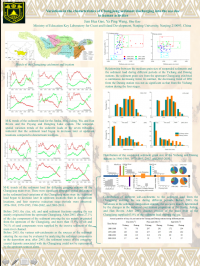CSDMS 2014 annual meeting poster Jian Hua Gao
Changes in water and sediment exchange between the Changjiang River and Poyang Lake under natural and anthropogenic conditions, China
Jianjun Jia, Key Laboratory of Submarine Geo-Sciences, Second Institute of Oceanography, State Oceanic Administration, Hangzhou 310012, China Hangzhou , China.
Albert J. Kettner, CSDMS Integration Facility, INSTAAR, University of Colorado, Boulder, CO 80309-0545, USA , United States.
Fei Xing, CSDMS Integration Facility, INSTAAR, University of Colorado, Boulder, CO 80309-0545, USA , United States.
Abstract:
To study the fluvial interaction between Changjiang River and Poyang Lake, we analyze the observed changes of riverine flux of the mid-upstream of Changjiang River Catchment, Poyang Lake Watershed and Poyang Lake basin. Inter-annual and seasonal variation of the water discharge and sediment exchange processes between Changjiang River and Poyang Lake are systematically explored to determine the influence of climate change as well as human impact (especially the Three Gorge Dam (TGD)). Results indicate that climate variation for the Changjiang catchment and Poyang Lake Watershed is the main factor determining the changes of water exchanges between Changjiang River and Poyang Lake. However, human activities (including the emplacement of the TGD) accelerated this rate of change. Relative to previous years (1956-1989), the water discharge outflow from Poyang Lake during the dry season towards the Changjiang catchment increased by 8.98 km3 y-1 during 2003-2010. Evidently, the water discharge flowing into Poyang Lake during late April-late May decreased. As a consequence, water storage of Poyang Lake significantly reduced during late April-late May, resulting in frequent spring droughts after 2003. The freshwater flux of Changjiang River towards Poyang Lake is less during the flood season as well, significantly lowering the magnitude and frequency of the backflow of the Changjiang River during 2003-2010. Human activities, especially the emplacement and operation of the TGD and sand mining at Poyang Lake imposes a major impact on the variation of sediment exchange between Changjiang main river and Poyang Lake. On average, sediments from Changjiang River deposited in Poyang Lake before 2000. After 2000, Changjiang River no longer supplied sediment to Poyang Lake. As a consequence, the sediment load of Changjiang River entering the sea increasingly exists of sediments from Lake Poyang during 2003-2010. As a result, Poyang Lake converted from a depositional to an erosional system, with a gross sediment loss of 120.19 Mt y-1 during 2001-2010, including sand mining.
* Please acknowledge the original contributors when you are using this material. If there are any copyright issues, please let us know and we will respond as soon as possible.

